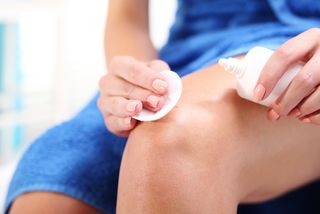Why Do Antiseptics Sting When Put on Cuts?

Imagine you're chopping vegetables when — oops! — you slice your finger. You run to the sink to wash the cut and then ready yourself for the inevitable sting that will come when you put antiseptic on the wound.
The antiseptic sting may last just a few seconds, but why does it happen at all?
The answer has to do with ethanol and hydrogen peroxide, which are often ingredients in antiseptics. Both of these agents activate receptors in the body that trigger a burning sensation, said Joseph Glajch, an analytical chemist at Momenta Pharmaceuticals in Cambridge, Massachusetts. [Why Do Doctors Prescribe Antibiotics for 10 Days?]
Ethanol activates the vanilloid receptor-1, known by the nickname VR1, according to a 2002 study in the journal Nature Neuroscience. VRI is responsible for creating a burning sensation when it's exposed to heat or certain chemicals, such as capsaicin in hot peppers, Glajch said.
VR1 is typically activated only at high temperatures, about 107 degrees Fahrenheit (42 degrees Celsius) or higher, he said. "Usually it's not turned on unless you're actually getting burned," Glajch told Live Science.
However, when ethanol comes into contact with the receptor, it lowers the temperature threshold to below body temperature, he said. "So, all of a sudden, you feel like you're getting burned, even though you're not getting burned," Glajch said.
He added that the burning sensation people feel in their throats when drinking an alcoholic shot is also associated with the transient receptor potential vanilloid (TRPV) family. These receptors are found throughout the inside of the body, according to a 2005 commentary published in the Journal of General Physiology.
Sign up for the Live Science daily newsletter now
Get the world’s most fascinating discoveries delivered straight to your inbox.
"[The ethanol] is activating that same receptor in the esophagus, and you're getting a temporary burning sensation," he said. "If you have something like a mixed drink, or a beer or wine, apparently the ethanol is not in a high enough concentration to turn on that receptor."
Hydrogen peroxide activates another receptor, known as transient receptor potential ankyrin 1, or TRPA1. The biology behind TRPA1 is less well-known than that of VR1, but it appears to work in a similar way, Glajch said.
"TRPA1 might be involved in the sensation of pain caused by H(2)O(2) [hydrogen peroxide]", a 2008 study in the European Journal of Neuroscience found.
Luckily, the burning sensation caused by both ethanol and hydrogen peroxide is fleeting. Moreover, it's not harmful, Glajch said.
"It's not destroying anything," he said. "It's basically causing this receptor to get turned on."
Original article on Live Science.

Laura is the archaeology and Life's Little Mysteries editor at Live Science. She also reports on general science, including paleontology. Her work has appeared in The New York Times, Scholastic, Popular Science and Spectrum, a site on autism research. She has won multiple awards from the Society of Professional Journalists and the Washington Newspaper Publishers Association for her reporting at a weekly newspaper near Seattle. Laura holds a bachelor's degree in English literature and psychology from Washington University in St. Louis and a master's degree in science writing from NYU.

